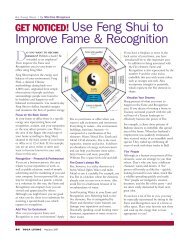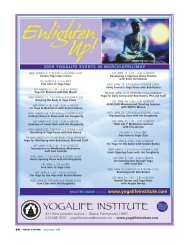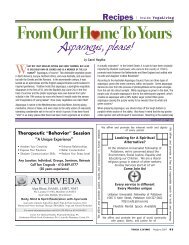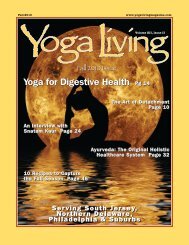Lizard Lunge Practice - Yoga Living Magazine
Lizard Lunge Practice - Yoga Living Magazine
Lizard Lunge Practice - Yoga Living Magazine
You also want an ePaper? Increase the reach of your titles
YUMPU automatically turns print PDFs into web optimized ePapers that Google loves.
<strong>Yoga</strong> Theory | by Sarah Murphy<br />
The Science Behind<br />
‘<strong>Yoga</strong> Bliss’<br />
SCIENCE IS CATCHING UP TO WHAT YOGIS<br />
ALREADY KNOW: yoga makes us feel better,<br />
and not just physically. <strong>Yoga</strong> has a significant,<br />
measurable impact on our mood and anxiety levels<br />
and even affects brain chemistry. In a study published<br />
in The Journal of Alternative and Complementary<br />
Medicine, a team led by researchers from Boston<br />
University reported the results of their study comparing<br />
yoga to walking. They measured mood and anxiety<br />
using paper-pencil assessments and used the brainimaging<br />
technique Magnetic Resonance Spectroscopy<br />
(MRS) to measure Gamma-Amino Butyric Acid<br />
(GABA), a neurotransmitter known to be a factor in<br />
anxiety and mood disorders.<br />
Participants in the study engaged in either a yoga<br />
exercise program or a walking program for 60 minutes,<br />
three times a week, for 12 weeks. At the end of<br />
12 weeks, the yoga participants had greater<br />
improvements in mood and anxiety compared to the<br />
walking group as well as increased GABA levels<br />
immediately after engaging in yoga practice.<br />
Many studies have already shown a link between<br />
exercise and mood – in fact, exercise has been found<br />
to be as effective as anti-depressants in treating mild to<br />
moderate depression. Further studies have shown yoga<br />
to be effective in treating depression, anxiety, and even<br />
epilepsy, all of which are related to decreased GABA<br />
levels. The present researchers found in a previous<br />
study that a 60-minute yoga practice increased<br />
GABA levels by 27%. The new study<br />
was intended to find out if increases<br />
in GABA definitely correlate with<br />
changes in mood and anxiety, as well<br />
as to see if changes in GABA were specific<br />
to yoga or would occur in a metabolically<br />
similar walking exercise.<br />
For the yoga-versus-walking study, participants were<br />
randomly assigned to either Iyengar-style yoga practice<br />
or a walking routine. All subjects were between<br />
18-45 years old. They each had three MRS scans: one<br />
before the intervention, one just before the last exercise<br />
session, and one immediately after. In addition, they<br />
all took paper-pencil measures of mood and anxiety at<br />
baseline, and after exercising at weeks four, eight, and 12.<br />
A certified Iyengar yoga teacher taught the yoga<br />
participants a sequence of yoga postures. The walkers<br />
were assigned to metabolically similar walking, at a<br />
2.5 mile-per-hour (mph) pace on flat ground that would<br />
mimic the metabolic impact of the specified Iyengar<br />
yoga practice. Thirty-four participants completed the<br />
study: 19 in the yoga group, and 15 in the walking group.<br />
There were no significant demographic differences<br />
between the groups, and the drop-out rates and<br />
participation rates were not statistically different, with<br />
each group participating in about two-thirds of sessions.<br />
After 12 weeks, the yoga participants reported decreased<br />
anxiety and improved mood measures including<br />
positive engagement, tranquility, and revitalization.<br />
The walkers reported only increased revitalization and<br />
no change in anxiety, tranquility, or engagement.<br />
Moreover, GABA levels in both groups were statistically<br />
similar at baseline and just before engaging in exercise,<br />
but rose after exercise only in the yoga group. This<br />
finding suggests that yoga does indeed impact the<br />
body’s production of the neurotransmitter GABA,<br />
while metabolically similar walking does<br />
not. However, the increase does not<br />
last, being apparent just immediately<br />
after engaging in yoga practice.<br />
These findings point to a physiological<br />
marker for ‘yoga bliss’-and a reason to keep<br />
coming back to your mat!<br />
▲<br />
24 YOGA LIVING Summer 2011
















